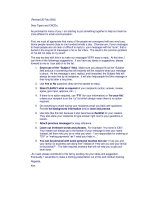Tài liệu How To Acquire Customers On The Web pptx
Bạn đang xem bản rút gọn của tài liệu. Xem và tải ngay bản đầy đủ của tài liệu tại đây (307 KB, 8 trang )
How to Acquire Customers
on the Web
by Donna L. Hoffman and Thomas P. Novak
Reprint r00305
MAY – JUNE 2000
Reprint Number
KEVIN WERBACH
STEVEN KAPLAN AND MOHANBIR SAWHNEY
RANJAY GULATI AND JASON GARINO
NICHOLAS G. CARR
MICHAEL BEER
AND NITIN NOHRIA
MODERATED
BY DENNIS CAREY
ANDREW HARGADON
AND ROBERT I. SUTTON
WARREN BENNIS
AND JAMES O’TOOLE
PAUL NUNES, DIANE WILSON, AND AJIT KAMBIL
A CONVERSATION WITH ALAIN-MICHEL
DIAMANT-BERGER
RICHARD METTERS, MICHAEL KETZENBERG,
AND GEORGE GILLEN
YOUNGME MOON AND FRANCES X. FREI
DAVID BOVET AND JOSEPH MARTHA
REGINA FAZIO MARUCA
WARREN D. MILLER
MONIQUE MADDY
JOHN SEELY BROWN
AND PAUL DUGUID
DONNA L. HOFFMAN
AND THOMAS P. NOVAK
CARL SHAPIRO
The E-Business Frontier:
Syndication: The Emerging Model for Business in R00311
the Internet Era
E-Hubs: The New B2B Marketplaces R00306
Get the Right Mix of Bricks and Clicks R00313
On the Edge: An Interview with Akamai’s George Conrades R00303
Cracking the Code of Change R00301
Lessons from Master Acquirers: A CEO Roundtable R00312
on Making Mergers Succeed
Building an Innovation Factory R00304
Don’t Hire the Wrong CEO R00302
FORETHOUGHT
The All-in-One Market F00301
E-Procurement at Schlumberger F00302
Welcome Back, Mom and Pop F00303
Exploding the Self-Service Myth F00304
Biogen Unchained F00305
Mapping the World of Customer Satisfaction F00306
HBR CASE STUDY
The Ghost in the Family Business R00308
FIRST PERSON
Dream Deferred: The Story of a High-Tech Entrepreneur R00307
in a Low-Tech World
THINKING ABOUT…
Balancing Act: How to Capture Knowledge Without Killing It R00309
BEST PRACTICE
How to Acquire Customers on the Web R00305
BOOKS IN REVIEW
Will E-Commerce Erode Liberty? R00310
oday, more than
1.6 million commercial sites
operate on the Web, all in fierce
competition for the attention of po-
tential buyers. E-tailers are finding
that it takes enormous marketing
expenditures to set themselves out
from the crowd, inspire Web shop-
pers to visit their sites, and then get
them to actually make a purchase.
Many e-tailers, in fact, are averag-
ing more than $100 to acquire a new
customer, and some are spending
upwards of $500. If a merchant is
selling high-ticket, high-margin
items, or if it can be sure of a steady
stream of repeat purchases, those
costs may make economic sense.
But for most, they’re suicidal – their
average customer acquisition cost is
higher than the average lifetime
value of their customers.
Until recently, e-tailers have been
able to convince investors that sky-
high spending on marketing is neces-
sary to stake out a position in the In-
ternet space. But the day of reckoning
is now approaching. Those companies
that have been able to bring their cus-
tomer acquisition costs down to earth
will have the best chance to thrive.
Those that haven’t will die.
harvard business review May–June 2000 Copyright © 2000 by the President and Fellows of Harvard College. All rights reserved.
BEST PRACTICE
HOW TO
ACQUI RE
CUSTOMERS
ON THE WEB
by Donna L.Hoffman and Thomas P. Novak
T
Customer acquisition is one of the biggest
challenges facing on-line companies today.
Success requires a fresh approach to
managing the marketing mix.
We’ve been studying on-line mar-
keting for seven years, and in the
course of our work, we’ve seen com-
panies experiment with many differ-
ent approaches to customer acquisi-
tion. One company that stands out
in our research is CDnow, the music
retailer. Although the company, like
other e-tailers, has struggled to earn
a profit amid the Web’s cutthroat
pricing, it has been a highly popular
site since its founding in 1994. It was
the fourth most-visited shopping
site in the fall of 1999, racking up
700,000 visitors and 5 million page
views every day. During the third
quarter of 1999 alone, it attracted
314,000 new customers. CDnow is
currently the most powerful on-line
music brand; in February it sur-
passed Amazon.com as the leader in
total on-line buyers with more than
1 million a day.
The company was one of the first
to develop a multifaceted, integrated
customer acquisition strategy that
reflects a sophisticated understand-
ing of the economics of an on-line
business. Whatever CDnow’s ulti-
mate fate, other virtual merchants
can learn a lot by taking a close look
at its strategy.
The Problem
with Banner Ads
When Jason Olim was 19, a friend in-
troduced him to Miles Davis’s clas-
sic album Kind of Blue. Entranced,
Olim went searching for more of
Davis’s recordings but was met with
poor service and limited selection in
traditional bricks-and-mortar retail
stores. Out of that frustration was
born a vision of a better way for mu-
sic buyers to connect with music.
Some six years later in August
1994, Jason and his twin brother,
Matthew, created CDnow in their
parents’ Ambler, Pennsylvania,
basement to provide music buyers
with knowledgeable recommenda-
tions, convenience, and a large selec-
tion. In its first month, CDnow
made a $14 profit from $387 worth
of business.
At the time, the Web was only be-
ginning to emerge as a platform for
commerce, and the main way to pro-
mote a site was to get it listed on
NCSA Mosaic’s “What’s New” page
or on the Global Network Naviga-
tor’s Whole Internet Catalogue site.
Then, as more e-tailers began to set
up shop, attention shifted to banner
ads as a way to attract traffic. Like
many e-tailers, CDnow initially saw
banner ads as a great way to promote
its site to Web surfers.
But many of those early on-line
selling efforts were conducted by
magazine salespeople who didn’t
really understand how the new
medium worked. Thinking of banner
ads in the same way as they thought
of a 30-second television spot or a
print ad in a magazine, they sought
to base their prices on the number of
people who would see an ad – what in
the trade is called “exposure-based
cost-per-thousand pricing.” (The
shorthand is CPM, with M being the
Roman numeral 1,000.) As with con-
ventional broadcast and print adver-
tising, this approach measures only
the amount of advertising delivered,
usually expressed in terms of “expo-
sures” or “impressions,” broken
down, at best, by demographic or
psychographic segments.
CDnow representatives found that
the script for such purchases went
something like this: The salesperson
would say, “Take this magazine,
which has 100,000 readers. Our Web
site has 100,000 visitors. The maga-
zine charges $10,000 for a full-page
ad. Our Web site charges $10,000 a
month for a banner ad.”
As the Olims very quickly realized,
this approach does not capitalize on
the unique advantages of the Inter-
net. On the Web, it’s not only possi-
ble to measure the amount of adver-
tising delivered, it’s also possible to
track the amount consumed. Specifi-
cally, it was possible for the Olims
to follow a prospect who clicked
through on a banner ad to the CDnow
Web site and to an actual purchase in
a way that is not possible with adver-
tising in traditional media.
But when the Olims tried to factor
that into the deal, they didn’t get
very far. The CDnow rep would say,
“Okay. What will I get for that
$10,000 a month? For example, how
many people will visit my site each
month?”
The response would be, “No guar-
antee on click-throughs. No guaran-
tee on impressions.”
Although the Web publisher would
quickly give in and agree to guaran-
tee some number of exposures, Web
publishers, borrowing again from
traditional print-advertising norms,
would try to justify their prices by
talking about their “circulation,”
which in this context actually meant
their unaudited number of unique
visitors.
It didn’t take long for CDnow to
determine that the CPMs being of-
fered at that time were inflated and
an obvious bad buy. Consider the fol-
lowing. Suppose the Web publisher
demanded a $70 CPM – that is, it
charged CDnow $70, a fairly com-
mon figure at the time, for every
1,000 visitors who were exposed to
its banner ad. That meant CDnow
was paying seven cents for each per-
son exposed to its banner. Then sup-
pose that 1% of the people who saw
the ad clicked through to CDnow’s
site. That would mean CDnow was
paying $7 for every visitor to its site.
Not bad, perhaps. But then consider
that only a very small percentage
of those visitors to CDnow through
that particular link were actually
converted into paying customers.
Assuming that conversion rate was
also 1%, the cost to acquire the new
customer became $700.
4
harvard business review May–June 2000
BEST PRACTICE
•
How to Acquire Customers on the Web
Donna L. Hoffman and Thomas P.
Novak codirect eLab (http://ecom-
merce.vanderbilt.edu), a research
center focused on Internet market-
ing and e-commerce, which they
founded together in 1994. They are
also marketing professors at Vander-
bilt University’s Owen Graduate
School of Management in Nashville,
Tennessee.
In effect,CDnow turned
its affiliate-marketing
partners into a virtual
commissioned sales force.
Now consider the net result of
such expenditures over the lifetime
value of each customer. We can’t
share CDnow’s actual numbers,
which are proprietary. But take this
hypothetical, and representative,
example: For the sake of argument,
let’s assume that the average on-line
customer spends $50 at an e-tailer’s
Web site on his or her initial visit.
Say the e-tailer’s gross profit margin
is 20%, so that the average customer
contributes a $10 profit on that ini-
tial transaction. Now let’s assume
that half of the e-tailer’s customers
return for another visit and click
their way through to an additional
$100 worth of purchases. That would
produce another $10 of gross profit.
If 10% of those customers come back
and conduct yet another $100 worth
of business, that’s $2 more, and so
on. In this way, the total gross profit
per customer approaches $25. As
long as advertising costs per cus-
tomer are below $25, there’s no prob-
lem. But in this context, $700 per
customer is disastrous.
That’s how the Olims saw it, and
so they began to think creatively
about other ways to drive buyers to
their site that would take better ad-
vantage of the Internet’s nature. It
didn’t take long. In November 1994,
only three months after the com-
pany was founded, CDnow began its
BuyWeb program, the first applica-
tion of what has come to be known
as “affiliate” or “associate” market-
ing programs.
On to Affiliate Marketing
The idea began with a partnership
program with Geffen Records. In
1994, Geffen was operating a Web
site promoting its artists and their
recordings. It wanted to offer fans an
easy way to buy music as well, but it
had no interest in building a fulfill-
ment operation. It contacted CD-
now to see if it might take on the ac-
tual sales functions.
The two companies soon agreed
that Geffen would put links on its
site to carry fans directly to the Web
pages devoted to Geffen artists at
CDnow’s site. It was a simple win-
win arrangement that enabled both
partners to sell more CDs, one at
wholesale, the other at retail.
harvard business review May–June 2000
5
How to Acquire Customers on the Web
• BEST PRACTICE
Jason Olim saw that the concept
underlying the Geffen arrangement
had much broader implications as a
marketing tool. CDnow could start
up a program that would motivate
other Web sites to put up links to its
site – not only record labels but also
much smaller sites that discussed or
reviewed music. Thus was born Buy-
Web (later rechristened the Cosmic
Music Network), the Web’s earliest –
and arguably most successful – affili-
ate program.
Over time, the BuyWeb program
grew. By the end of 1994, it had a
dozen or so members. By the end of
1995, that number had grown to a
few hundred. At that time, CDnow
launched a revenue-sharing arrange-
ment: when a customer clicked
through from an affiliate’s Web site
to the CDnow Web site and actually
bought a CD, CDnow gave 3% of the
revenue from the sale back to the af-
filiate. That gave member Web sites
the inducement they needed to join
the program and provided them with
an important opportunity to make
money on the Internet. In effect, CD-
now turned its affiliate-marketing
partners into a virtual commissioned
sales force. (For a general discussion
of the spread of revenue-sharing pro-
grams on the Internet, see the sidebar
“Revenue-Sharing Marketing Strate-
gies: A Webwide Trend.”)
In this way, small Web sites like
Lauri’s Dreamy World and Mass
Confusion Music created value for
CDnow by recommending various
compact discs to their cyber-
browsers that they could then pur-
chase at CDnow’s site. The links
that such sites placed next to their
music reviews gave their visitors the
option to effortlessly purchase the
reviewed disc on the CDnow site.
Lauri’s Dreamy World and Mass
Confusion Music received value in
the form of the commission paid by
CDnow each time a visitor clicked
on the CDnow link and purchased
the highlighted CD.
The BuyWeb program evolved
into “Cosmic Credit” in the spring
of 1997. Unlike high-profile Web
portal sponsorship deals, CDnow’s
Cosmic Credit program targets low-
volume, nonprofessional sites of
music fans. In late 1999, CDnow cre-
ated the Cosmic Music Network on
top of the Cosmic Credit program.
The Cosmic Music Network builds
on the success of the Cosmic Credit
program by allowing unsigned
artists to put up a Web page at the
CDnow site, upload music that fans
can download for free, and link their
work to more well-known bands
elsewhere in the CDnow store. To-
day, CDnow pays referring sites any-
where from 7% to 15% on a sliding
scale based on volume when visitors
click through and make a purchase
on the CDnow site.
The Cosmic Music Network is
significant for several reasons. First,
it gives CDnow a staggeringly large
number of potential marketing part-
ners. Second, the program, which
has over 250,000 members, is one of
CDnow’s most significant sources
of customer acquisition, allowing
the company to advertise to poten-
tial customers it would otherwise
not be able to reach. No way could
CDnow afford the administrative
burden of buying advertising on all
250,000 of these sites, nor could an
intermediary do so cost-effectively.
The mere administrative expense of
filing that many insertion orders
would be prohibitive. But members
identify and sign themselves up au-
tomatically for the Cosmic Music
Network with a few clicks on CD-
now’s site, so the system is not only
affordable but grows naturally. As
the Web expands, so can this strat-
egy, which means that CDnow can
potentially enroll millions of mem-
bers into the program.
Third, and most important, unlike
banner ads, revenue-sharing pro-
grams are “webby” by nature. They
build on the interconnections intrin-
sic to the Web and on the Web’s abil-
ity to monitor and track activity in
real time. With the Cosmic Music
Network, CDnow knows for a fact
As efficient as the affiliate
program is, it does only
reach potential customers
who are already on-line.









